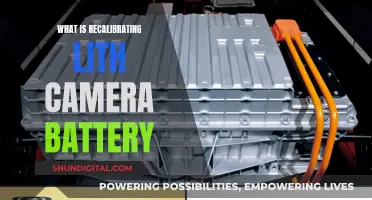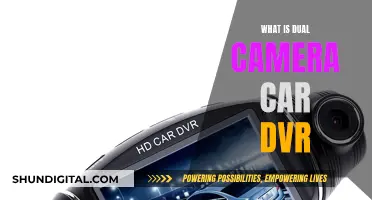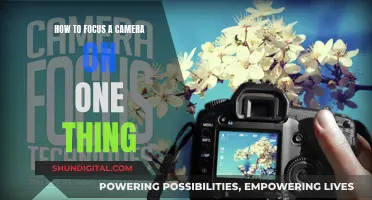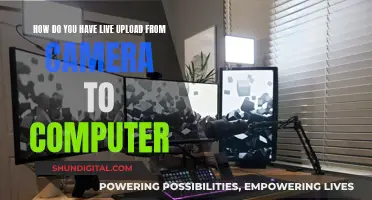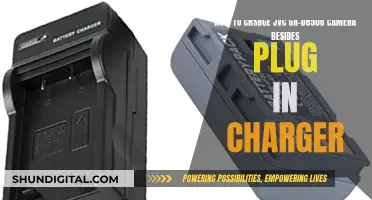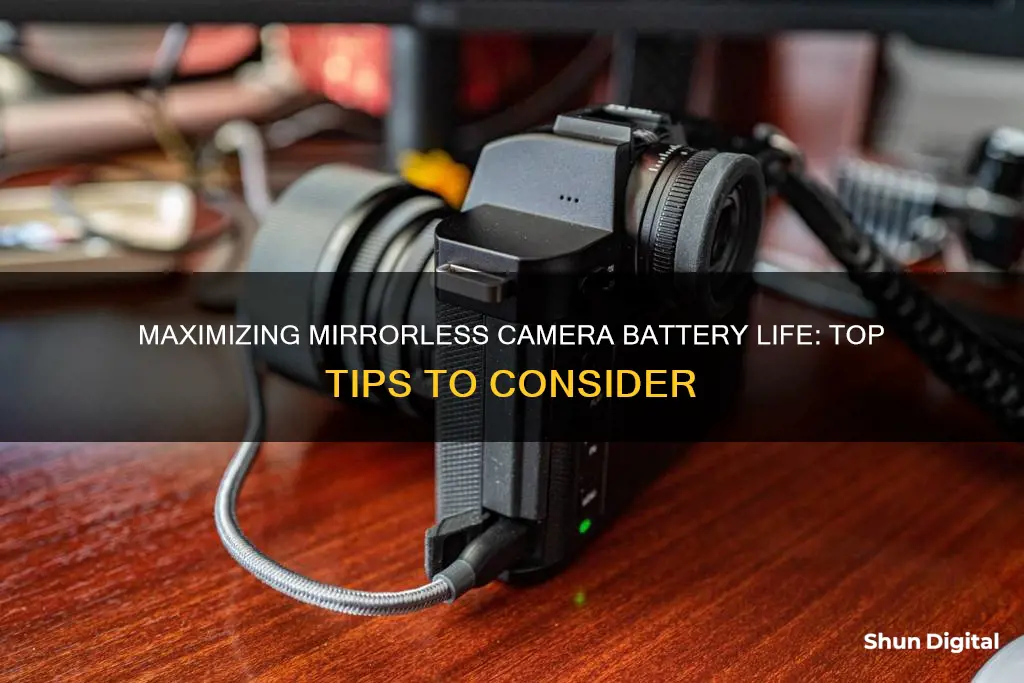
Mirrorless cameras have shorter battery life than DSLRs because they have smaller batteries and power a display almost all the time. However, there are several ways to increase battery life and make the most of your mirrorless camera.
Firstly, it is important to know your camera settings. Most models have an energy saver function that can be useful if you plan to take lots of pictures throughout the day. You can also adjust the performance, frame rate, and brightness of your camera to optimise battery life.
Secondly, use your camera wisely. Only use autofocus when you need it, and turn off image stabilisation unless it is required. Put your camera in airplane mode to disable connections, and use a single frame per second unless you are photographing action.
Thirdly, always carry spare batteries and consider purchasing third-party chargers.
Finally, consider investing in a mobile charger to recharge your battery on the go.
What You'll Learn

Turn off autofocus and image stabilisation when not needed
Turning off autofocus and image stabilisation when not needed is a great way to extend the battery life of your mirrorless camera.
Autofocus is a handy feature, but it can drain your battery quickly, especially if you're continuously refocusing on static subjects. If you're photographing stationary objects or scenes, it's best to turn off autofocus and adjust the focus manually. This way, you'll save battery power and won't have to worry about constantly recharging your camera.
Image stabilisation is another feature that can be a significant drain on your mirrorless camera's battery. If you're using a tripod or shooting at shutter speeds faster than 1/1000, you can safely turn off image stabilisation. It won't make much difference at fast shutter speeds, but it will help conserve your battery power.
By being mindful of when to use these features, you can make your mirrorless camera's battery last longer and ensure you don't miss any important shots due to a dead battery.
Additionally, you can also try to use the viewfinder instead of the LCD screen, as it consumes less power. You can also adjust the brightness of the LCD screen to a lower setting or turn off the auto-brightness feature. This will help reduce power consumption and extend your battery life.
Low Battery, Low Quality: Camera Performance Impact
You may want to see also

Turn off the LCD preview
Turning off the LCD preview on your mirrorless camera is one of the most effective ways to save battery power. Here are some detailed tips to help you maximise your battery life:
Turn off Automatic LCD Preview:
The automatic LCD preview feature, which displays the image you just captured, can be a convenient way to review your photos. However, constantly using the LCD screen drains the battery quickly. It is advisable to turn off this feature and instead utilise the viewfinder to review your images. By doing so, you can extend your shooting time and reduce the need for frequent battery changes.
Customise Your Camera Settings:
Modern mirrorless cameras offer various customisation options to enhance your shooting experience. Explore the settings in your camera's menu and adjust them according to your needs. For example, you can set a shorter duration for the LCD to remain active, especially if you don't require it frequently. Additionally, disabling the "Sunlight" or "Outdoor Shooting" mode can help conserve battery power, as these modes tend to increase screen brightness and consume more energy.
Deactivate the LCD Screen:
If your camera has a viewfinder, consider deactivating the LCD screen when it's not in use. This simple step can significantly reduce power consumption. Many cameras have a dedicated button to turn off the LCD, allowing you to quickly enable or disable it as needed. Remember to reactivate the screen when you need to review your photos or adjust settings.
Adjust Exposure Settings:
When working in manual or semi-automatic mode, you can choose how the LCD/EVF displays your exposure. One option is to preview the exposure, showing you a darker or brighter live view based on your settings. This can be helpful in specific situations, like studio photography with strobes. However, if you don't have particular requirements, it's advisable to opt for optimal brightness. This way, the camera won't continuously adjust the aperture or boost the live view, conserving battery power.
Resist the Urge to Playback:
While it's tempting to constantly playback your photos and videos, doing so can quickly drain your battery. Try to resist the urge to review your images or videos repeatedly. Instead, focus on capturing the moment and reviewing your work at a later time when you have access to a charging station. This discipline will help you extend your shooting time and make the most of your battery life.
Charging Lorex Cameras: Quick and Easy Guide
You may want to see also

Put your camera in airplane mode
Putting your mirrorless camera in airplane mode is a great way to increase its battery life. This is because, by default, most cameras are set up to connect to the web and periodically scan for it. They also have Bluetooth capabilities. All of these processes work in conjunction with the processor to drain your camera's battery life.
When you put your camera in airplane mode, it disables linking to your phone and other devices. These functions are always running in the background, whether you are trying to sync up or not, and they consume a lot of power. So, by turning on airplane mode, you can prevent unnecessary battery drain and make your battery last longer.
It is important to note that airplane mode will also disable your camera's ability to beam images to your phone wirelessly. So, if you need to transfer images, simply turn off airplane mode for the required duration and then turn it back on.
Additionally, if your camera has built-in Wi-Fi or Bluetooth capabilities, you can manually turn these off to further conserve battery life. These features can decrease your battery life, so turning them off when not in use can help extend your shooting time.
By following this tip and being mindful of your camera's settings, you can effectively increase the battery life of your mirrorless camera and ensure that you don't miss any important moments due to a drained battery.
Ejecting Camera Batteries: A Step-by-Step Guide for Exilim Models
You may want to see also

Use a single frame per second
Using a single frame per second is a great way to extend the battery life of your mirrorless camera. This is because the more frames per second your camera shoots at, the more battery power it consumes.
When you're photographing a static subject, such as a building, you don't need a high frame rate. In these situations, set your camera to shoot at one frame per second. This will help to conserve battery power.
It's easy to forget to change the frame rate after photographing action, but it's worth making a habit of doing so. By only using a higher frame rate when you need it, you'll be able to make your camera's battery last longer.
If you're shooting in continuous mode, the autofocus motor will be constantly running as long as you have the shutter pressed halfway. This uses a lot of power, so it's best to avoid using continuous autofocus unless it's necessary.
Instead, use single-shot autofocus. This way, the autofocus motor will turn off as soon as it achieves focus, preserving your battery.
Another way to save battery power is to turn off autofocus altogether and focus manually. Modern mirrorless cameras will temporarily boost their sensitivity to help with focusing in low-light conditions, so autofocus assist isn't always necessary.
By using a single frame per second and being mindful of your autofocus settings, you can significantly extend the battery life of your mirrorless camera.
Charging Enel3e Camera Battery: Alternative Methods to Try
You may want to see also

Use the latest battery for your camera
Using the latest battery version for your camera is one of the most effective ways to improve battery life. The latest batteries have a higher capacity and can provide a significant boost in performance. For example, the Nikon EN-EL15c battery offers increased battery life compared to its predecessors, making it a worthwhile investment for photographers using Nikon Z cameras.
Upgrading to the latest battery can make a noticeable difference in how long your camera can last on a single charge. This is especially beneficial for mirrorless cameras, which are known for their shorter battery life compared to DSLRs. By using the newest battery available for your camera model, you can maximise your shooting time and minimise the need for frequent recharging.
In addition to improved battery life, newer batteries may also offer enhanced performance. Manufacturers often release updated batteries that are specifically designed to power the advanced features of their latest camera models. These batteries can provide a more stable power supply, ensuring that your camera operates efficiently and reliably.
It is worth noting that original equipment manufacturer (OEM) batteries can be expensive. However, there are third-party options available that offer comparable performance at a more affordable price. When purchasing third-party batteries, it is important to choose reputable brands to ensure quality and compatibility with your camera.
While using the latest battery can significantly improve your camera's performance, it is not the only factor that affects battery life. The way you use your camera also plays a crucial role. By adopting good habits, such as turning off features when not in use and minimising LCD usage, you can further extend your battery life.
Additionally, proper battery care and maintenance are essential. Keeping your batteries warm in cold environments and storing them properly when not in use will help maintain their performance and longevity.
By combining the use of the latest battery with efficient shooting practices and proper care, you can maximise your camera's battery life and ensure that you're always ready to capture the perfect shot.
Charging Karma Grip: GoPro Power Tips
You may want to see also
Frequently asked questions
Only use autofocus when you need it. Turn off image stabilization unless it is necessary. Put your camera in airplane mode. Use a single frame per second unless you are photographing action.
Use the newest battery for your camera. Carry extra batteries. Turn off the camera when not in use.
Drop your EVF frame rate. Turn off GPS. Turn down the EVF/LCD brightness. Turn off VR/Stabilization when not essential.
Avoid constantly reviewing your photos. Avoid using the flash unless necessary. Avoid using Live View.
Keep the end cap supplied by the manufacturer on the batteries. Store them with a mid-range charge in a cool, dry place.


